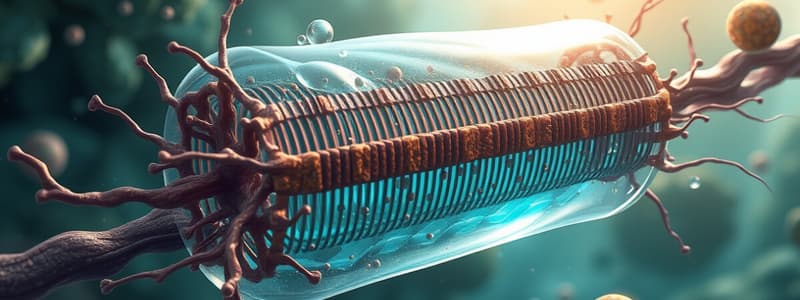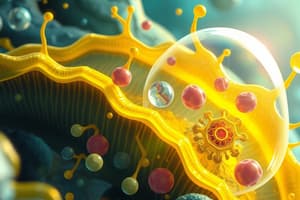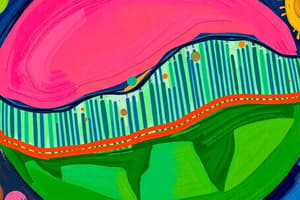Podcast
Questions and Answers
What is the primary function of anaerobic respiration, and how does it differ from aerobic respiration?
What is the primary function of anaerobic respiration, and how does it differ from aerobic respiration?
Anaerobic respiration primarily produces ATP without the use of oxygen, often through glycolysis and fermentation, unlike aerobic respiration which relies on oxygen for ATP production.
Explain the significance of stem cells in the process of differentiation.
Explain the significance of stem cells in the process of differentiation.
Stem cells are significant as they are unspecialized cells capable of self-renewal and differentiation into specialized cell types, forming tissues and organs in multicellular organisms.
What role do villi play in the digestive system?
What role do villi play in the digestive system?
Villi increase the surface area of the intestinal lining, enhancing nutrient absorption during digestion.
Describe how capillaries facilitate gas exchange in the body.
Describe how capillaries facilitate gas exchange in the body.
How do stomata and guard cells regulate gas exchange in plants?
How do stomata and guard cells regulate gas exchange in plants?
Describe the role of phospholipid bilayer in cell membrane structure.
Describe the role of phospholipid bilayer in cell membrane structure.
What is the main difference between passive and active transport mechanisms in cells?
What is the main difference between passive and active transport mechanisms in cells?
Explain the significance of the surface area-to-volume ratio in relation to cell size.
Explain the significance of the surface area-to-volume ratio in relation to cell size.
How do eukaryotic cells differ from prokaryotic cells in terms of organelles?
How do eukaryotic cells differ from prokaryotic cells in terms of organelles?
What processes are involved in aerobic respiration and why is oxygen essential?
What processes are involved in aerobic respiration and why is oxygen essential?
Flashcards are hidden until you start studying
Study Notes
Cell Membrane
- Consists of a phospholipid bilayer featuring embedded proteins, cholesterol, and glycoproteins, enabling selective permeability.
- Passive transport allows substances to move along concentration gradients through diffusion and osmosis, maintaining homeostasis.
- Active transport uses ATP to move ions and molecules against their concentration gradients, notably exemplified by the sodium-potassium pump.
- Endocytosis enables the uptake of large molecules by enclosing them in vesicles, with phagocytosis as a specific form where cells engulf large particles.
- The movement of substances is influenced by concentration gradients, molecular size, and chemical properties; cell size is restricted due to the surface area-to-volume ratio.
Prokaryotic and Eukaryotic Cells
- Essential requirements for all cells include energy, gases (such as O₂ and CO₂), nutrients (sugars and amino acids), water, and waste elimination.
- Prokaryotic cells lack nuclei and membrane-bound organelles, are generally smaller, possess a single circular DNA strand, and are typically single-celled organisms.
- Eukaryotic cells are characterized by complex organelles (chloroplasts, mitochondria), specialized functions (e.g., rough ER for protein synthesis, lysosomes for degradation), and can exist as single-celled or multicellular organisms.
- Shared evolutionary origins indicate common functional and structural features between prokaryotic and eukaryotic cells.
Internal Membranes and Enzymes
- Membrane folding increases surface area, enhancing the efficiency of enzyme reactions, particularly seen in mitochondrial structures.
- Specific enzymes regulate metabolic processes, ensuring that biochemical reactions occur at appropriate rates under varying conditions.
- Enzyme specificity is determined by the active site's ability to bind to distinct substrates, facilitating accurate biochemical reactions.
- Reaction rates are influenced by environmental conditions, including temperature, pH levels, the presence of inhibitors, and concentrations of reactants and products.
Energy and Metabolism
- Adenosine triphosphate (ATP) is produced from glucose during cellular respiration, functioning as an essential energy currency of the cell.
- Photosynthesis converts light energy into chemical energy, producing glucose and oxygen from CO₂ and water, occurring in light-dependent and light-independent stages.
- Aerobic respiration requires oxygen and comprises glycolysis, the Krebs cycle, and the electron transport chain for ATP production.
- Anaerobic respiration generates ATP without oxygen, primarily through glycolysis followed by fermentation pathways.
- Energy metabolism can be illustrated through chemical equations and diagrams showcasing the various processes involved.
Cell Differentiation and Specialisation
- Stem cells are undifferentiated and possess the unique ability to self-renew and differentiate into various specialized cell types.
- Differentiation processes lead to the formation of specialized cells that compose tissues and organs within multicellular organisms.
- Multicellular organization is hierarchical, with cells forming tissues, which in turn compose organs and systems.
Gas Exchange and Transport
- Efficient gas exchange relies on structures that feature a large surface area, moist environment, thin walls, and extensive capillary networks, exemplified by alveoli and gill structures.
- Capillaries facilitate the exchange of vital substances, including water, oxygen, and nutrients, between bodily cells and the bloodstream.
- Diagrams and tables are useful for interpreting and predicting material exchanges involving alveoli, capillaries, and muscle tissues.
Exchange of Nutrients and Wastes
- Villi in the digestive tract enhance nutrient absorption by increasing surface area available for transfer.
- Digestive enzymes such as amylase (carbohydrates), protease (proteins), and lipase (fats) play essential roles in the breakdown of macromolecules.
- The process of protein breakdown yields nitrogenous wastes like urea, which must be eliminated from the body.
- Nephrons are the functional units of the kidney, facilitating urine production through filtration, reabsorption, and secretion across structures like Bowman’s capsule and the Loop of Henle.
- Waste removal processes include glomerular filtration and selective reabsorption or secretion to manage waste levels efficiently.
Plant Systems — Gas Exchange and Transport Systems
- Stomata and guard cells regulate the movement of gases (O₂, CO₂, water vapor) in plant leaves, crucial for photosynthesis.
- Leaves contain mesophyll, epidermal tissue, and vascular bundles, facilitating efficient gas exchange and photosynthesis.
- Photosynthesis occurs primarily in mesophyll cells, closely linked to the plant's capability to perform gas exchange and energy production.
- Xylem tissue is responsible for transporting water and minerals from roots to the rest of the plant, while phloem distributes sugars and nutrients.
- Water movement in plants is driven by root pressure, the transpiration stream, and cohesion of water molecules.
- Factors such as light intensity, temperature, wind, and humidity significantly influence transpiration rates in plants.
- Phloem plays a critical role in translocating the products of photosynthesis and other nutrients throughout the plant system.
Studying That Suits You
Use AI to generate personalized quizzes and flashcards to suit your learning preferences.




